Cat Grooming
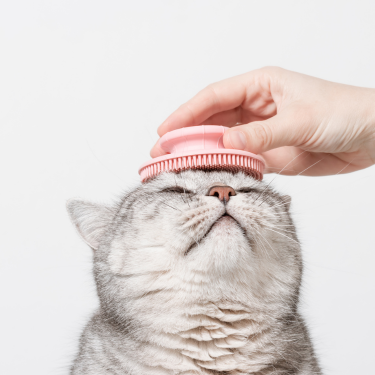
Most cats take great pride in their appearance, dedicating nearly half their waking hours to grooming themselves to perfection. Although they are independent and prefer to care for themselves, it’s still important for you to assist with their grooming routine.
Grooming your cat is an essential part of pet care, ensuring your cat not only looks great but also feels great. Regular grooming helps maintain your cat's beauty and provides valuable bonding time between you and your pet. Additionally, it allows you to monitor their overall health, making it easier to detect any unusual signs or potential health issues, such as lumps or bumps.
The benefits of cat grooming
Cat grooming might appear superficial, but it offers several benefits beyond just making your cat look good. During grooming, whether your cat is self-grooming or being brushed by you, they experience:
- Enhanced circulation
- Improved muscle tone
- Smoother fur, which provides better insulation
- Stimulation of glands at the base of the coat to waterproof the fur
- Even distribution of sebum, which helps protect and waterproof the coat and skin
- Cooling effects from the saliva spread during grooming, especially in hot weather
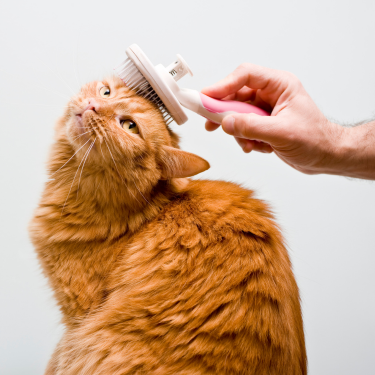
How cats groom themselves
If your cat has ever shown affection with a gentle lick, you may have noticed their rough tongues. These tongues are covered in tiny bristles that help them comb out dirt and loose hair from their coats, much like a hairbrush. This grooming process is crucial for maintaining a healthy coat.
As cats often swallow hair during grooming, they may end up coughing up fur balls. This is quite normal, so there’s no need to be concerned. To reduce the amount of fur they shed and minimize fur balls, assist with grooming using a gentle brush. Regularly grooming your cat with a wide range of tools, including a nail clipper for their claws, helps remove dead fur and keeps their coat healthy.
Short haired cats typically groom themselves well, but long haired cats may need extra help. With their more extensive fur, they might miss spots and require additional grooming to remove dead fur and keep their coat in top condition. By helping with these grooming tasks, you ensure your cat is happy and their fur remains clean and healthy.
When you should help with cat grooming
Start grooming your cat from an early age to integrate it into their regular routine. Curious kittens might get into messy situations, so you may need to assist with their clean up as well.
As cats age, they can become stiff and may struggle to reach certain areas, making regular grooming an essential part of their care throughout their lives. Grooming your cat from a young age helps build a strong bond through physical contact and creates a foundation of trust.
Short haired cats typically groom themselves effectively, but a brief brush once a week can help maintain their coat and provide quality time together. Long haired cats, on the other hand, need daily grooming to remove dead fur, manage loose hair, and prevent matting and knots.
Using a wide range of grooming tools, including a nail clipper for their claws, keeps their coat healthy and their cat happy. Regular grooming helps manage their fur and ensures they remain comfortable throughout their lives.
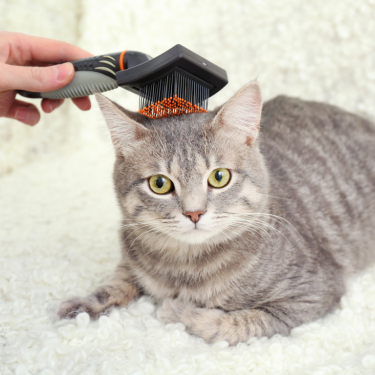
How to groom your cat
Grooming can vary in length depending on your cat's breed and fur type. To ensure effective grooming sessions, have the right equipment on hand and establish a dedicated grooming area. Address your cat's specific needs by consulting our top grooming tips for more detailed guidance.
Fur Brushing
For short haired cats, use a fine toothed metal comb once a week to remove any knots or tangles, and a natural bristle or rubber cat brush to eliminate loose hair. Gently brush or comb your cat’s fur in the direction it grows. Sweep the coat towards the head with the bristly brush, then smooth it back down to maintain a healthy coat.
For long haired cats, daily grooming with a steel comb is essential. Use your fingers to tease out any knots, and a damp cloth if needed. Avoid using scissors to prevent accidental cuts, and seek help from your vet for severe or numerous knots.
To make grooming more pleasant for your cat, offer food treats, gentle strokes, and soothing words. This can help keep your cat happy and calm during the process.
During grooming, take the opportunity to check your cat's overall health, including their teeth, eyes, ears, and gums. If grooming becomes stressful for your cat, it’s best to take a break and try again later. Regular grooming with the right tools, including a nail clipper for their claws, helps manage loose hair, remove dead cat fur, and keep their coat healthy.
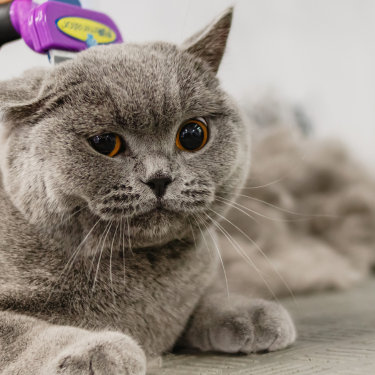
Checking your cat's claws
Cat grooming goes beyond just enhancing your cat’s appearance; it also offers a regular opportunity to monitor their claws. While outdoor cats and those who frequently use scratching posts often manage their claws through natural wear and tear, indoor or elderly cats may need extra help.
Regular weekly checks and occasional claw-trimming prevent claws from growing inward into their pads, similar to an ingrown toenail, which can lead to pain and infection. Overgrown claws in senior cats can also indicate osteoarthritis, so it’s important to consult your vet if you notice any issues.
Since cats rely on their claws for self-defense, scratching, and climbing, we recommend trimming them only when absolutely necessary.
How to Trim Cat Claws
Before you begin, make sure your cat’s claws actually need trimming. Outdoor cats, who rely on their claws for climbing and defense, should only have their claws trimmed if they are at risk of overgrowth. Even then, only certain claws may need attention. For cats with extra toes (polydactyl) or dew claws located on the inside of their legs below the wrist, monitor these closely as they don’t naturally wear down and may require more frequent trimming.
Develop a habit of checking your cat’s claws weekly. If you notice any ingrown claws, consult your vet, as your cat may need pain relief or antibiotics. Additionally, if claws are ripped, torn, or missing, seek veterinary advice.
If you're new to trimming, ask your vet or veterinary nurse to demonstrate the proper technique and review your method. If you're not confident, you can always have your vet handle the trimming.
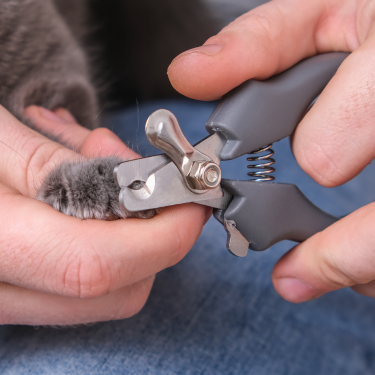
Introduce claw-trimming to your cat from an early age, ideally starting with kittens, as their claws are soft and are usually filed rather than clipped. For adult cats, use specially designed cat-claw clippers, which should be kept sharp and well-maintained. These are available from pet stores or your vet avoid using human nail clippers or scissors.
To trim, gently press your cat's paw between your fingers to extend the claw. Trim only the transparent tip of the claw, avoiding the sensitive blood vessel in the center. Never clip beyond the pointed tip to prevent hitting the ‘quick,’ which can cause pain and bleeding. If you accidentally cut the quick, apply silver nitrate sticks (available from your vet) and press with cotton wool to stop the bleeding. If bleeding persists, contact your vet for assistance.
While checking claws, also examine the paw pads for cuts or foreign objects and look between the toes for any signs of soreness. Contact your vet if you find anything unusual.
Brushing your Cats teeth
The final step in your weekly cat grooming routine is a quick brush of your cat's teeth. Use either a cat toothbrush or a cotton bud to clean their teeth, and be sure to use toothpaste specifically formulated for cats, as human toothpaste can upset their stomachs. For more information on brushing your cat's teeth and its importance, refer to our guide.
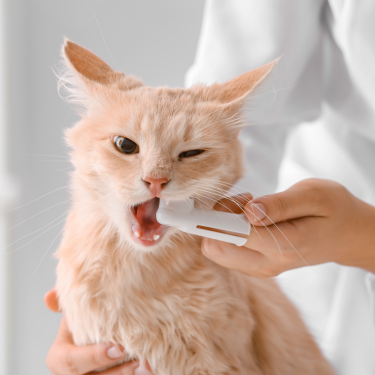
Bathing your Cat.
Cats generally don't require regular baths since they usually groom themselves. However, if your cat returns home covered in something unpleasant, such as mud or with matted fur, you may need to step in and bathe them. Keep in mind that bathing cats can be challenging and stressful, as most of them dislike water.
Need additional tips on cat grooming? Visit our article on Tips for Bathing a Cat for more helpful advice.
Cleaning your cats ears
Cats are generally good at keeping themselves clean, but they sometimes need a bit of extra help reaching certain areas. Cleaning a cat’s ears can be particularly challenging, as their ears are sensitive and some cats may have trouble maintaining cleanliness on their own.
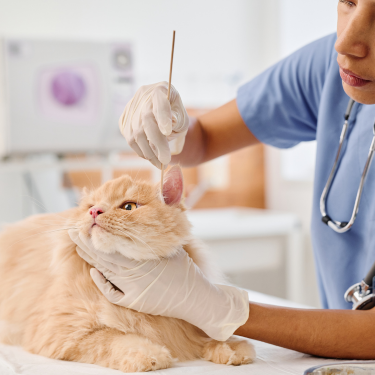
Grooming a kitten
When you first bring a new kitten home, you might wonder if they need grooming right away or if it’s better to wait until they’re older. It can be challenging to determine what basic grooming your kitten requires and how to establish an appropriate schedule. However, starting early is beneficial and helps them get accustomed to the grooming process.
Why do cats overgroom?
If you notice your cat engaging in excessive grooming, it may be due to stress from changes in their environment. Overgrooming can lead to skin inflammation, sores, and hair loss, and in severe cases, your cat might even begin to bite at their skin.
Additionally, overgrooming can result in your cat swallowing a lot of hair, which can form hairballs a combination of dead hair and digestive juices in the stomach.
Regular grooming is essential, especially during shedding seasons, to prevent these issues.

















